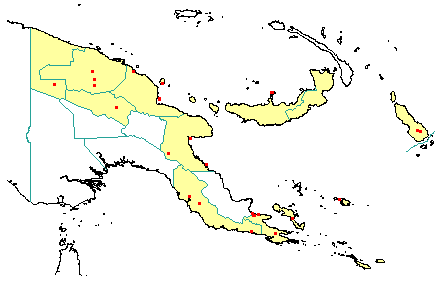
in PNGplants database
PNGTreesKey – Syzygium tierneyanum (F.Muell.) T.G.Hartley & L.M.Perry |
Barry Conn (NSW) & Kipiro Damas (LAE).
Guide to trees of Papua New Guinea
Copyright held by the authors, National Herbarium of New South Wales, and Papua New Guinea National Herbarium
Journal of the Arnold Arboretum Vol. 54: 200 (1973)
Family: Myrtaceae
Dicotyledon
Timber Group: Occasional timber species
Field Characters: Small sub-canopy tree or Large canopy tree (up to c. 25 mm high); Bole cylindrical (up to c. 65 cm diam., occasionally up to 150 cm); straight (almost bole often short, up to c. 26 m long) or crooked; buttresses buttresses present (on larger trees) or buttresses absent; spines spines absent; aerial roots aerial roots absent; stilt roots stilt roots absent; Bark grey, red, or brown, rough, slightly peeling or scaly or flaky (often papery); Subrhytidome (under-bark) green; less than 25 mm thick, 5.0-10.0; bark blaze consisting of one layer; faintly to non-aromatic; outer blaze white, yellow (pale (straw-coloured), or pale brown, markings absent, rarely granular without splinters or fibrous; inner blaze pale brown, yellow (pale (straw-coloured), or white, markings absent, fibrous or rarely granular without splinters; bark exudate (sap) absent; terminal buds not enclosed by leaves.
Indumentum: Complex hairs absent; stinging hairs absent; mature twig indumentum (hairs) absent (becoming scaly).
Leaves: Leaves spaced along branches, opposite (in pairs, opposite one another on the branchlet), simple (a leaf composed of a single blade); petiole present, not winged, attached to base of leaf blade, not swollen; leaves broadest below middle, 8.5-19.0 cm, 3.0-7.0 cm; symmetric, entire, not dissected or lobed, acuminate, venation pinnate, secondary veins open, not visible (occasionally (or indistinct) or not prominent, but visible, intramarginal veins present (sometimes 2; sometimes indistinct near base of lamina); leaves lower surface green, upper surface dark green (dull (to subglossy) or green, indumentum (hairs) absent; present (oil dots small, but numerous); domatia absent; stipules absent.
Flowers: Inflorescence on the trunk or branches (borne on branchlets below leaves), flowers on a branched axis, cones absent; flowers bisexual, stalked, flowers with many planes of symmetry, 15.0-25.0 mm long, diameter large (more than10 mm diam.) (c. 15 mm diam.); perianth present, with distinct sepals and petals whorls, inner perianth white or cream-coloured (densely covered with oils dots); 4, free; stamens 100, present, free of each other, free of the perianth (attached to hypanthium); ovary inferior, carpels joined (when more than one), locules 2; styles solitary, 1.
Fruits: Infrutescence arranged on branched axis, fruit 20.0 (c.) mm long, 20.0 (c.) mm diam., red or occasionally white, not spiny, fleshy, simple, indehiscent, drupe; seeds 1, about 10 mm long (5-8 mm long) or to about 5 mm long, not winged, broad (as wide as long), seed 1-10 mm diam. (5-8 mm diam.).
Distribution: West Sepik, East Sepik, Madang, Morobe, Western Highlands, Central, Milne Bay, Papuan Islands, New Britain & Bougainville.
 | Botanical records in PNGplants database |